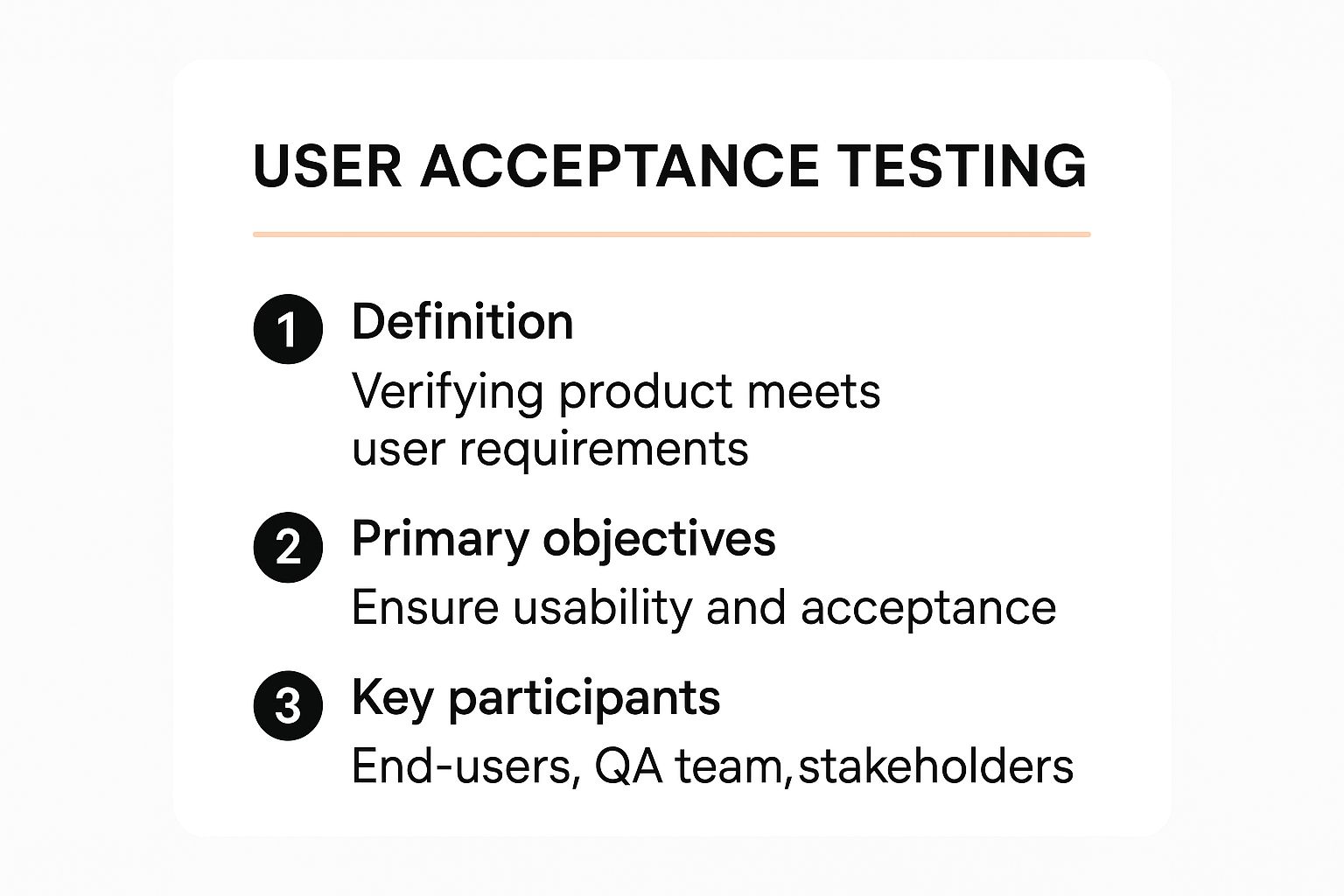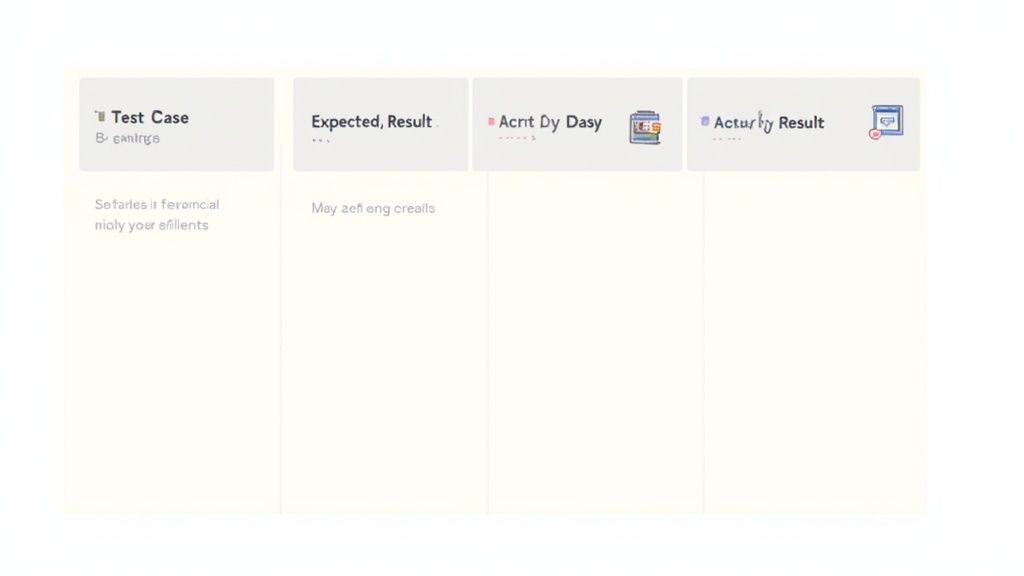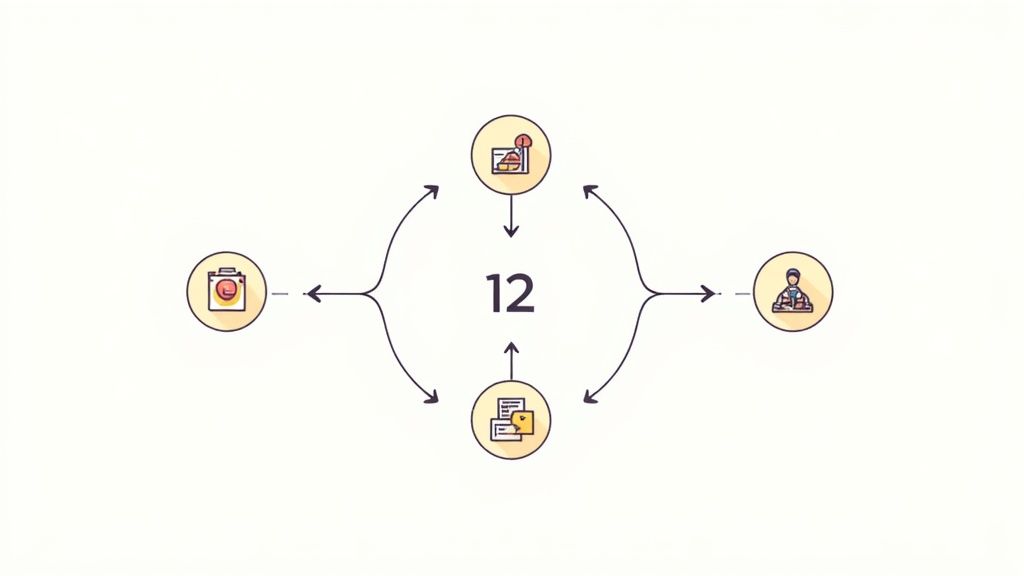User Acceptance Test Template: Create Flawless Software Launches
- shems sheikh
- May 18
- 14 min read
The Real Power Behind User Acceptance Test Templates
User Acceptance Testing (UAT) is the crucial final step before a software product launches. It's the stage where real users step in to validate the software, ensuring it truly meets their needs and expectations. But effective UAT isn’t a game of chance; it requires a structured, organized approach. That’s where the power of a well-designed user acceptance test template comes in. These templates provide a roadmap, guaranteeing consistent testing procedures and thorough coverage.
Why Templates Are Crucial for Successful UAT
Templates transform potentially disorganized testing into a streamlined validation process. They establish a framework that clearly defines the testing scope, objectives, and criteria. Think of a team developing an e-commerce website. A UAT template would detail scenarios like adding items to a shopping cart, going through checkout, and managing account settings. This ensures essential functions undergo rigorous testing by end-users before the site goes live.
Furthermore, user acceptance test templates boost stakeholder engagement. A well-structured template effectively guides testers, making it simpler for them to grasp their roles and responsibilities. This organized approach clarifies expectations and facilitates communication between testers, developers, and project managers. The result? Higher quality feedback and quicker resolution of any issues. Want to measure the effectiveness of your UAT templates? Exploring effective employee engagement strategies can provide valuable insights.
The Growing Importance of Structured UAT
The increasing focus on user-centric software development has fueled the demand for organized testing methods. The global User Acceptance Testing (UAT) services market reached a value of $1.074 billion in 2023 and is projected to climb to $1.65 billion. This impressive growth highlights the rising importance of UAT templates in guaranteeing software aligns with user expectations. For deeper insights, explore the latest on UAT market growth.
Key Elements of Effective UAT Templates
What transforms a UAT template into a truly powerful tool? Here are several key components:
Clear Test Objectives: Define precisely what aspects require testing and the rationale behind it.
Step-by-Step Instructions: Provide straightforward, concise instructions that are easily understandable, even for non-technical users.
Expected Results: Clearly outline the anticipated outcome for each test case.
Pass/Fail Criteria: Establish unambiguous criteria to definitively determine test success or failure.
Reporting Mechanisms: Include a dedicated section for testers to document their findings and any encountered problems.
Adapting Templates for Different Scenarios
It’s important to remember that there's no one-size-fits-all solution. User acceptance test templates need to be adapted to the specific requirements of each project. Factors like industry regulations, the complexity of the project, and the demographics of the user base all influence the template design. Explore further resources in our sitemap. This customization ensures the template stays relevant and effective. A UAT template for a banking app, for example, would have different criteria compared to a template for a mobile game.
Building UAT Templates That Actually Drive Results
A solid understanding of user acceptance testing (UAT) principles is crucial for software development success. However, putting these principles into practice through well-crafted UAT templates is where the real value lies. Let's explore how effective templates can transform your testing process and deliver meaningful results. The infographic below highlights key aspects of user acceptance testing, including its definition, objectives, and the participants involved.

As the infographic illustrates, UAT is a collaborative process, not just a technical checklist. It involves end-users, the QA team, and other stakeholders working together to ensure the product truly meets user needs. This collaboration is essential for ensuring high usability and user satisfaction.
Defining Clear Test Objectives
Effective UAT begins with well-defined objectives. These objectives guide the testing process and ensure alignment with overall business goals. For instance, if a new feature aims to increase user engagement by 20%, the UAT objective should directly reflect this. The template should specify how this increase will be measured during testing. Connecting objectives to business outcomes ensures valuable insights from the UAT process.
Designing Effective Step Sequences
Clear, concise, and easy-to-follow instructions are essential for a good UAT template. Even non-technical stakeholders should be able to execute test steps confidently. Each step should build logically upon the previous one, leading to a successful outcome. This structured approach ensures consistent testing across all users and minimizes the risk of errors due to misinterpretation.
Creating Unambiguous Pass/Fail Criteria
Unclear pass/fail criteria often lead to ambiguous feedback like "it works differently than expected." A strong UAT template eliminates this ambiguity. For example, if a test involves form submission, the criteria might specify a successful submission requires both a confirmation message and an email notification. This level of detail provides concrete evidence of success or failure, removing subjective interpretations.
Incorporating User Personas and Environmental Considerations
High-performing teams understand that context is crucial. They incorporate user personas and environmental factors into their UAT templates. A software application for healthcare professionals will have different user experience considerations and testing scenarios than a social media platform. This customization ensures the template reflects real-world usage. Factors like network connectivity, device types, and operating systems should also be considered.
Utilizing Dependency Mapping
Dependencies between features can significantly impact testing. A well-designed UAT template incorporates dependency mapping. For instance, if Feature A depends on Feature B, the template should clearly outline this relationship. This helps testers understand the correct test execution order and identify potential cascading failures early on. Adapting templates to your specific context, instead of relying on generic processes, makes your testing more relevant and impactful. Just as Beep helps teams provide clear visual feedback on web projects, a well-designed UAT template clarifies the testing process for everyone involved.
To help you understand the key differences between basic and comprehensive UAT templates, the table below provides a detailed comparison. It highlights which components are essential for different project complexities.
Core UAT Template Components Comparison: A detailed comparison of essential components in basic vs. comprehensive UAT templates, helping readers understand which elements are necessary for different project complexities.
Component | Basic Template | Comprehensive Template | When to Include |
|---|---|---|---|
Test Objectives | High-level objectives | Specific, measurable objectives tied to business goals | Always |
Test Steps | Simple step-by-step instructions | Detailed steps with screenshots or visual aids | For complex workflows or non-technical users |
Pass/Fail Criteria | Basic pass/fail criteria | Detailed criteria with specific expected results | Always |
User Personas | Not included | Included, with specific scenarios for each persona | For projects with diverse user groups |
Environmental Considerations | Basic considerations (e.g., browser compatibility) | Detailed considerations (e.g., network conditions, device types) | For projects with specific technical requirements |
Dependency Mapping | Not included | Included, outlining dependencies between features | For projects with complex interconnected features |
This table highlights how comprehensive templates provide more detailed guidance and account for various factors, making them suitable for complex projects. Basic templates are sufficient for simpler projects with fewer variables. Choosing the right template ensures your UAT process is effective and efficient.
Crafting Test Scenarios Users Actually Want to Execute

Let's face it: many test scenarios feel like a chore. This can seriously affect the quality of feedback during user acceptance testing (UAT). This section explores creating engaging and realistic scenarios that encourage stakeholders to actively participate and offer valuable insights. This leads to a more successful software launch. The global software testing market is expected to hit $67.56 billion by 2030, emphasizing the increasing importance of quality assurance, including UAT. For more statistics, check out this report: Software Testing Market.
Identifying Critical User Journeys
First, identify the most important user journeys within your application. These are the key actions users take to achieve their goals.
For example, in e-commerce, a key journey might be browsing, adding items to a cart, and checking out. Focusing on these core journeys ensures you’re testing the most vital functions from the user’s point of view.
Recognizing Edge Cases and Potential Issues
While core user journeys are essential, don't forget about edge cases. These are scenarios outside typical usage, yet can still happen.
What if a user enters a wrong coupon code or their internet goes down while uploading a file? These less common situations often uncover hidden problems. Understanding these helps structure your user acceptance test template.
Designing Realistic and Relevant Scenarios
Create scenarios that resonate with users’ real experiences. Instead of saying "test the login," try "Log in as a returning customer who forgot their password."
This not only tests the login but also the password retrieval process. This realistic approach boosts user engagement and delivers more useful feedback.
Involving Actual End-Users in Scenario Development
Include real end-users in scenario creation. Their direct experience provides invaluable insights into real-world use and potential issues.
This not only helps create authentic scenarios but also makes users feel more involved in the UAT process. This collaboration results in better testing and a higher quality product.
Balancing Coverage and Time Constraints
Balance thorough testing with reasonable timeframes. While testing is important, avoid lengthy scenarios that discourage participation.
Prioritize crucial functions and consider other testing methods for less critical areas. This targeted approach ensures valuable feedback without overwhelming users.
Writing Clear and Concise Instructions
Finally, write clear instructions that everyone can understand. Avoid technical terms and use visuals like screenshots or diagrams.
This reduces confusion and ensures consistency. Clear instructions mean fewer questions, freeing up your team and improving the UAT process.
Tailoring Templates To Your Unique Testing Challenges
A generic user acceptance test template is like an ill-fitting suit – functional, but not ideal. This section explores how organizations tailor their user acceptance test (UAT) templates to meet specific needs, creating a process that truly works. Just like a tailor adjusts a suit for the perfect fit, customizing a UAT template ensures it addresses your unique challenges.
Adapting To Industry and Methodology
Different industries and project methodologies have distinct requirements. A regulated industry, like finance, demands meticulous documentation and traceability. An agile environment prioritizes flexibility and rapid iteration. Your UAT template must reflect these differences. For example, a financial institution’s template might include specific sections for compliance checks, while a tech startup using Agile might incorporate a simpler, evolving template.
The Rise of Agile and Remote Work
The shift towards hybrid and remote work necessitates flexible testing frameworks. The growing trend towards such work environments underscores the need for adaptability in testing. A 2022 survey by TestMonitor highlights this, finding industry trends include a rise in hybrid and remote work, a focus on tester engagement, and an emphasis on test design and planning. Find more detailed statistics here. This makes customizable UAT templates even more vital.
Customizing Based On Team Experience
Team experience also plays a vital role in template design. A team of seasoned testers may not need as much detail as a team with less UAT experience. Tailoring the level of guidance ensures the template is helpful without being overwhelming. For instance, a template for experienced testers might focus on high-level objectives, while one for newer testers could include step-by-step instructions with screenshots. This targeted approach maximizes efficiency. You might also find this helpful: How to master dynamic use cases.
Addressing Stakeholder Preferences and Project Complexity
Stakeholder preferences and project complexity also factor into template customization. Some stakeholders might prefer detailed reports, while others prefer summarized findings. A complex project with multiple interconnected features requires a more comprehensive template than a smaller, more straightforward project. Consider using tables to capture key data for projects involving numerous features. This adaptability keeps everyone engaged and informed.
Incorporating Compliance, Accessibility, and Performance
Effectively incorporating regulatory compliance checks, accessibility validation, and performance thresholds directly into the template streamlines testing. This ensures these essential aspects aren't overlooked and become integral to the UAT. For example, a website template could include specific tests for accessibility compliance, such as keyboard navigation and screen reader compatibility. Maintaining template usability and stakeholder engagement throughout this process is crucial. By integrating these elements strategically, organizations ensure thorough testing without sacrificing efficiency.

Beyond Spreadsheets: Modern Tools For UAT Excellence

While spreadsheets were once a staple, today's User Acceptance Testing (UAT) demands a more robust approach. This section explores how modern tools and platforms are transforming UAT template creation, distribution, and analysis. We'll compare specialized UAT platforms, test management solutions, and collaboration tools to understand their roles in streamlining the UAT process. These modern tools support distributed teams and offer valuable real-time progress insights. This shift is crucial for navigating the complexities of modern software development.
Specialized UAT Platforms
Specialized UAT platforms offer tailored features for managing the entire UAT lifecycle. These platforms frequently include features such as built-in template management, automated test execution, and detailed reporting. Some platforms even allow testers to evaluate software in simulated user environments, offering a realistic testing experience. This can be particularly valuable when testing complex applications with diverse user requirements.
Test Management Solutions
Test management solutions take a broader perspective, integrating UAT into a holistic quality assurance strategy. These tools typically include functionalities for creating, executing, and tracking test cases, which can easily be adapted for UAT. Many test management solutions also integrate with other development tools, promoting a more streamlined and connected workflow. This integration ensures that UAT is aligned with the broader development lifecycle.
Collaboration Tools For UAT
Collaboration tools like Slack or Microsoft Teams play a vital role in UAT, especially for geographically dispersed teams. These platforms foster seamless communication between testers, developers, and stakeholders. They enable efficient feedback sharing and swift issue resolution. Real-time communication ensures that everyone stays informed and potential roadblocks are addressed promptly. Tools like Beep enhance collaboration further, especially for web projects, with its visual feedback features. Learn more about how Beep elevates teamwork and communication through their dynamic reviews.
Evaluating UAT Tools: Value vs. Glitz
Not all features deliver equal value. Some may appear impressive in a demonstration but prove cumbersome in real-world scenarios. A complex reporting system overflowing with data, for instance, may be less useful than a simpler system presenting key metrics. Honest feedback from implementation experts is crucial for discerning which features truly add value and enhance efficiency.
Balancing Functionality and Usability
Organizations must balance the need for robust features with the importance of user-friendliness. A small startup might prioritize a simple, intuitive tool, while a large enterprise may require a more complex platform with extensive integration options. Choosing the right tool hinges on understanding your team's specific needs and technical capabilities.
Integrating UAT With Your Development Ecosystem
Integration with your existing development tools is a critical factor. A UAT tool that seamlessly integrates with your current systems, such as Jira or other project management software, facilitates a smooth flow of information. This minimizes manual data entry and ensures that all stakeholders have access to the most up-to-date UAT results. This connectivity enhances transparency and collaboration throughout the entire development process.
To guide you in choosing the right tool for managing user acceptance test templates, we've compiled the following comparison:
To help you make the best decision, we've compiled this comparison of some popular UAT template management tools:
UAT Template Management Tools Comparison: A comprehensive comparison of popular tools for managing UAT templates, including features, pricing tiers, and best use cases for different organization sizes.
Tool | Key Features | Price Range | Best For | Integration Capabilities |
|---|---|---|---|---|
Test case management, defect tracking, reporting | Varies depending on edition | Medium to large organizations | Integrates with Jira, Confluence, and other Atlassian products | |
Test case management, reporting, requirements management | Varies depending on the number of users | Small to large organizations | Integrates with Jira, Redmine, and other project management tools | |
Test management, exploratory testing, reporting | Varies depending on the number of users | Medium to large organizations | Integrates with Jira, Selenium, and other testing tools | |
User Acceptance Testing (UAT) | Test planning, execution, tracking, and reporting | Varies widely | Organizations of all sizes | Often integrates with project management and communication tools |
This table provides a brief overview of the diverse tools available, each catering to different needs and budgets. Choosing the right UAT tool can significantly improve your software quality and overall user satisfaction.
Getting Real Buy-In for Your UAT Template Process
A perfect user acceptance test (UAT) template can be useless without team adoption. This section offers proven strategies for introducing or updating UAT templates effectively, encouraging enthusiasm instead of resistance. Consider using the GitHub Pull Request Template for managing code reviews, improving teamwork and enhancing code quality. Structured approaches like this are invaluable for UAT processes as well.
Training and Onboarding for UAT Templates
Effective training is key for successful UAT template adoption. Provide clear, concise training materials that explain the template's purpose, how to use it, and the benefits it offers.
Hands-on workshops or online tutorials allow stakeholders to familiarize themselves with the template practically. For teams with diverse learning styles, consider offering training in multiple formats.
Securing Executive Sponsorship
Executive support is critical for driving change. Present a compelling case to leadership, highlighting how standardized UAT templates can improve software quality.
Explain how using templates can reduce development costs and accelerate time to market. When leaders champion the initiative, it signals its importance and promotes team-wide buy-in.
Establishing Clear Roles and Responsibilities
A successful UAT process requires clearly defined roles. Outline who is responsible for creating, reviewing, and executing test cases.
Also specify who handles reporting and resolving issues. This clarity prevents confusion and ensures accountability throughout the entire testing process. For example, defining the roles of developers, testers, and product managers helps streamline the feedback process.
Measuring Adoption and Template Effectiveness
Track key metrics to assess the effectiveness of your UAT template process. Monitor how many teams are using the template to measure the adoption rate.
Analyze stakeholder feedback to pinpoint areas for improvement. Quantifiable data, like a reduction in post-launch bug reports, can demonstrate the template’s positive impact.
Identifying and Addressing Implementation Challenges
Anticipate potential roadblocks and address them proactively. Resistance to change is normal. Provide support to those struggling with the new process.
Address their concerns and emphasize the template’s advantages. Regularly solicit feedback and adapt the template to ensure it remains relevant and effective.
Communicating the "Why"
Clearly communicate the purpose and benefits of the UAT template to all stakeholders. Explain how it improves testing consistency and reduces ambiguity.
Highlight how it ultimately contributes to a higher-quality product. When individuals understand the template's value, they're more likely to embrace it. For instance, emphasize how a well-defined template improves communication between testers, developers, and product managers.
Creating Sustainable Momentum
UAT template implementation isn’t a one-time event, it's a continuous process. Encourage continuous improvement by regularly reviewing the template and soliciting feedback.
Use these insights to refine the template, ensuring it aligns with evolving project needs and stakeholder preferences. This iterative approach fosters a culture of continuous improvement and maintains long-term engagement. This promotes ownership and reinforces the importance of structured UAT, building a culture of quality and ensuring long-term success.
Measuring What Matters in Your UAT Template Journey
Moving beyond simply checking off completed tests unlocks a treasure trove of valuable UAT information. This section explores practical methods for evaluating the effectiveness of your user acceptance test (UAT) template, from identifying patterns in defect detection to measuring stakeholder satisfaction. This shift from basic metrics to a more in-depth analysis can significantly enhance your software development process.
Establishing Baseline Measurements
Begin by establishing baseline measurements that align with your organization's objectives. These baselines provide a foundation for tracking progress and demonstrating the impact of template improvements. For example, a baseline could be the average number of defects discovered per UAT cycle, or the average time required for testers to complete the test scenarios. These initial measurements become benchmarks for future comparisons.
Tracking Progress and Comparing Results
Tracking progress across multiple releases helps identify trends and areas requiring attention. Compare results between different projects or teams to understand how effective the template is in various situations. This comparison helps pinpoint factors that contribute to success or highlight areas where adjustments are needed. This comparative analysis can also reveal best practices to share across the organization.
Quantitative Metrics: Defect Severity Distribution
Analyze quantitative data, such as the distribution of defect severity. A large quantity of critical defects might indicate problems with the software itself, or with the testing process. Tracking the severity of identified defects provides valuable insight for prioritizing fixes and refining the development process. This data-driven strategy promotes effective resource allocation.
Qualitative Insights: Tester Confidence and Team Feedback
Don't overlook the importance of qualitative aspects. Tester confidence levels and feedback from the implementation team offer valuable insights into the template's usability and effectiveness. High confidence and positive feedback typically indicate a well-designed template. Conversely, low confidence or negative feedback suggests a need for revisions. Gathering this feedback pinpoints areas where the template could be made clearer, more efficient, or better aligned with user requirements. Tools like Beep's dynamic reviews can further enhance team collaboration and feedback during testing.
Collecting Meaningful Insights From All Participants
Solicit feedback from all UAT participants, not just testers. Including input from developers, product managers, and even end-users creates a more comprehensive understanding of the template's strengths and weaknesses. Different stakeholders offer unique perspectives, leading to more well-rounded improvements. This collaborative approach ensures the template meets the needs of everyone involved in the software development lifecycle.
Analyzing Patterns and Identifying Opportunities for Improvement
Search for patterns in the collected data. For example, a recurring problem in a specific template section might indicate a need for clearer instructions or additional training. Analyzing these patterns allows you to identify opportunities for improvement and make focused changes to the template. This iterative process ensures the template stays relevant and effective over time.
Communicating the Impact of Template Refinements
Finally, communicate the business impact of your template enhancements to executive stakeholders. Show how an improved template results in fewer defects, shorter testing cycles, and greater user satisfaction. Quantifying these benefits reinforces the value of structured UAT and justifies the investment in template development and refinement. Clear communication ensures continued support for your UAT process.
Ready to streamline your web project reviews and boost team collaboration? Try Beep today! Get started with Beep in under a minute – no credit card required.

.png)
Comments